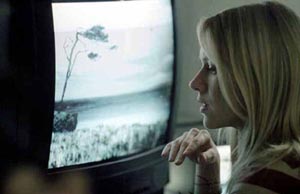This text has been submitted as an original contribution to cinetext on September 12, 2003.
Repetition: The Ring and the Diabolical Imaginary
|
|
by Matthew Sharpe |
Both versions of The Ring, the English-speaking (starring Naomi Watts et al) and the original Japanese, start with a kind of doubling. Two girls sit on a bed, and one tells a tale. There is a video that one of them has heard about. The story goes that whoever watches the video immediately receives a phone call. Down the line, a voice says: seven days. Then the phone hangs up. Exactly seven days from the time when the person watches the video, they die an inscrutably horrible death. The girl who tells the tale then confesses that she had watched the video, seven days ago. The tension created by this admission is next momentarily released. She confesses to only be jokingshe hasnt really seen the video. Then, however, the phone rings. As the girl answers the phone downstairs (her parents are away [sic.], and are calling her), something uncanny happens. The television comes on, of its own accord. The girl tries to turn the television off. But each time the television comes on again, of itself, even after its cord has been pulled out of the wall. At this point, amidst heightening horror, we become aware that the story within the story The Ring is true. The gap between the films reality, and the fiction that is told within it, is folding or collapsing. The person that the girl had been hoping to convince by joking, it seems, was first of all herself.
At this point, in the English version, water unnaturally starts to seep into the girls room. The next thing we see are people gathering at the girls wake, discussing how unusual it is for such a young girl to have diedapparentlyof a complete heart failure. Andwe hear whisperseveryone who had seen the video with her (four teens) have all died unaccountably the previous day.
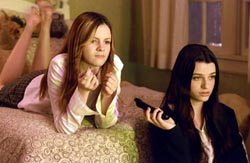
|
Clips |
Truth or tale? The two girls on the bed. The Ring (Dreamworks, 2002).
The Ringand especially, I will say, the English-speaking versionis probably one of the most terrifying films you will ever see. There is something starkly horrifying about the films premise, as already laid out in what I have recounted in the introductory paragraph. The story (in both versions) follows the fate of a lead female character who knows the family of the deceased girl. In each case, she hears of the story of the video at the wake, and becomes involved in trying to get to the bottom of it [sic.]. Her pursuit takes her out to a remote lodge where the girl had stayed seven days before her death. In each version, the heroin happens upon, and bravely watches, the video. Just as in the story, the phone then rings. In the English-speaking version, a whispered voice says: seven days. More on this anon. The distance between our heroin detective and the story she is investigating, it seems, is also collapsing.
Things only become more troubling when she gets a hold of the deceased girls photos. All the photos from before she has watched the video are in order. Yet, in every photo after the event, the faces of the four youths are blurred (precisely) beyond all recognition. In increasing anxiety, the heroin calls upon her ex-partner, asks him to take a photo of her, and to watch the video. When he takes a photo of her, her face is completely blurred. And after he watches the video, as if in a dream, the phone promptly rings.
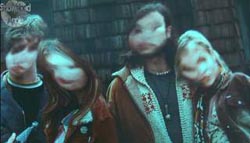
|
The blury photo. The Ring (Dreamworks, 2002). Screenshot courtesy of Snowblood Apple.
If we can keep our nerve (or maybe in order to keep our nerve), what ensues in The Ringand especially, to repeat, the Anglophone versioncan be seen as a choice opportunity for us to bum up on our Lacanian first principles. Everything is there (but not right until the end, unfortunately!) to suggest a water tight (sic.) reading of The Ring according to the principles of the strictest Lacanian orthodoxy, at least if we limit ourselves to everything said before 1960.
To recollect: the early Lacan is precisely the Lacan that fellow French theorist Jacques Derrida took severely to task for misreading Edgar Allen Poethat master of the uncannyin his Postcards. The letter always returns to its destination, according to this Lacan. What he means is roughly the following. The truth is that we are speaking beings, who are socialised into a linguistic community bound by certain laws and codes that precede us, and whose principles in principal exceed our conscious mastery. But our socialisation does not happen without remainder. As Freud had argued, if we are rational animals, it is only at a cost. As Lacan put it, we are the animals who are tortured by the language and social codes that we are bound to inhabit. Certain of our polymorphous desiresfor we always have had more than oneneed to be harnessed, controlled, andfailing thatforcibly repressed. The desires do not disappear when they are repressed, however. They insist to trouble our adult equanimity in dreams, slips, andif we are unluckyin symptoms. The point for this reading of The Ring is this. Lacans idea is that the unconscious is structured like a language. The repressed desires cannot find direct expression. Yet the charge of energy that they carry will not cease demanding its release. What occurs when a symptom occurs is thus an indirect attempt of this repressed desire to find satisfaction. The repressed desire uses the battery of the signifierall the combinations our lexicon makes available to usto make itself heard. Symptoms insist, that is, there where communication failed: where the subject had desires which could not be integrated or accepted into his or her mature social identity. One just doesnt talk about that stuff. Secondly, however, symptoms remain for the early Lacan attempts to re-establish the circuits of the individuals self- and social communication. In Lacans view, that is, the repressed letters that have become associated with the prohibited drives want to be recognised in words. The letter wants to return to its destination. My point for a reading of The Ring (both versions) is that the video that the people see within it, seven days before their letter fatally arrives at its destination, seems to precisely match the description of the early Lacanian symbol-symptom.
Everything happens as if it were precisely this. First, consider the content of the video. The video flickers on and off between a series of apparently unrelated images. There is no apparent narrative, just as Freud has taught us that the sense of narrative we have in dreams is only a secondary revision there to veil the true meaning. The true meaning, which is (precisely) analytic, consists in and at the level of the individual elements. Dreams are like rebuses, or hieroglyphs, or some other form of writing, Freud says. Each picture does not tell a story: it represents a signifier pictorially. The overall impression we get when this deeply uncanny video, then, is exactly like the impression we often have when waking from a dream: namely, one of near-complete confusion. In somewhat more technical language, we can say that the text of this video is under-determined. It needs our interpretative work.
And this is exactly what our heroinin this respect at least a good Freudiansets about providing within either version of The Ring. Where the coded message of the video was, there my interpretation will be. The point of the video, for her, is first of all that it has a point. It becomes a question of chasing up what each of the images stand for. Through some adept investigations, and aided by her estranged partner, the heroin in fact manages to re-narrate what is only fragmentarily expressed in the video-symptom. And there really is a story to tell. Before you die, the popular telling has it, you see the ring. The ring is a seering circle of thin white light against a background of pitch darkness. It precedes and then ends the video. It features briefly when the video returns after seven days, and your time is up. But there is more to it than that. The ring is what you would see if you were stuck at the bottom of a well. It is also what a young girlin the Anglophone version, named Samara (more anon)presumably saw when her mother threw her down the bottom of a well concealed beneath the holiday cabin where the fatal video enters circulation. The girl survived down there in the darkness, it is surmised by the heroinefor seven days.
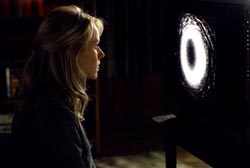
|
Clips |
"Before you die you see the Ring." Rachel watching the video. The Ring (Dreamworks, 2002).
What then would be more sound than to interpret the video, and the fate of those who watch it, as a distorted form of communication, like a symptom? Seemingly, Lacans idea that the letters of the unconscious are dead letters, and tied to what Freud had called the death drive, appears to be directly in play. What is apparently expressed in the video would then be the desire that the broken circuit of communication that defines the horrid fate of the girl Samara be restored. The deaths of those who watch the video after seven days would be metaphoric repetitions of the (repressed, unmarked) death of the murdered girl Samara, down even to the water that seeps out of the TV in the English version when the deadly letter arrives at its destination. And the repetitions repeat precisely insofar as we dont understand this meaning. The letter-video of Samaras (repressed) story, that is, wants to return to its proper destination, even if it is only to be transformed into letters that might adorn a tombstone, in a public cemetery. Tell my story!, as Hamlet finally managed to demand.
And so The Ring proceeds with a certain mechanical inevitability. Or so it seems. By piecing together the clues, our heroine is not only able to re-tell the story. Aided by her ex-partner, she actually repeats the situation of the murdered girl. She finally even descends down the well, getting exactly to the bottom of things. There, uncannilybut well have to return [sic.] to thisshe finds the body of Samara, perfectly preserved, immersed in the water. The body floats to the surface, and in a moment of human pathos that relieves for a moment the sheer terror, the heroine takes the body in her arms. At this point, just like a good symptom, Samaras body dissolves in the heroins arms. Where it was, so now the appropriate, publicly recognised symbols will be. There will be a funeral, and the girls story will at last see the light of public recognition. Or so we surmise.
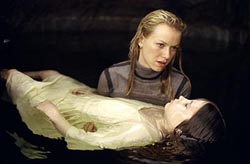
|
A fleeting moment of relief: Rachel and Samara in the well. The Ring (Dreamworks, 2002).
In both versions, then, we cut now to the heroin and her ex-partner, whoin touching alignment with our Lacanian interpretationnow seem reconciled, even to the point where their love may be redeemed. Everything seems now then to have been resolved. No longer will the son be haunted by Samara, or any other ghosts. The dead have been buried. In a way that would no doubt disgust Gilles Deleuze, the Oedipal triangle has been peaceably restored. The only problem is that the film doesnt end at this point, no matter how ardently we may all want it to. We are dealing here, that is, with that arch-Hitchcockian device of the artificial ending. (One of the most striking recent examples of this, by the way, is The Talented Mr. Ripley. , with its fade out shot of the ship sailing towards the horizon with Ripley still unapprehended, five minutes before the film ends).
Things now become doubly uncanny, we would have to say (at least). For, if you like, the film now stages a second, re-doubled, or repeated repetition. In a word, Samaras curse does not cease to apply. She is not finished with us yet. There is a compulsion to repeat, as Freud would say, that insists beyond the resolution of the inter-subjective dialectics. We are much closer, then, to the meaning of the death drive that most interests Derrida in his writings on Freud, orin factthe later Lacans notion of the drive [pulsion] which operates beyond desire. The following day, seven days after the heroines partner had seen the video, we see what it is that has caused the deaths of the previous unfortunates. As he sits in his studio, the television comes ononce again, all by itself. In the English-speaking version, water starts seeping out of it. The screen eventually takes on a coherent picture. At first we see the ring. Then we see a troubled picture of the fatal well. Next, we see that someone is trying to get out of the well. It is a girl, her face completely concealed behind a matt of straight black hair. She gets out of the well, and lurches towards the camera. Finally, in what is an absolutely horrific moment, she actually starts to climb out of the television, and begins to make her way towards the hapless hero, long nails clawing at the ground. The mode of the killingand the use of time lapse in the Anglophone version will strike youis simply by a look of unrelenting hatred that Samara gives him between parted strands of her hair. There could be few purer instances of the evil eye, oras is saidthe look of death. The hero falls dead in terror. He is literally scared to death.
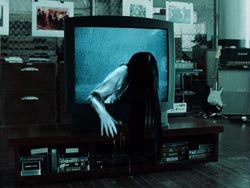
|

|
Clips |
The look of death: Samara emerges from the TV and gives Noah the evil eye. The Ring (Dreamworks, 2002).
What then is there to say about this second level of repetition, which insists before or beyond anything that anyone might say about it?
We can approach the problem with this reflection: The other major problem with the Lacanian interpretation I have given is simply that it runs a little too smoothly. Accordingly, it succeeds too well in domesticating The Ring in a way that simply doesnt account forindeed it effaces itwhat is actually its most striking feature, and that which explains the almost cult-status it has achieved: namely, the sheer sense of diabolical, uncanny horror that pervades especiallyand I do have to repeatthe Anglophone version of the film.
So here is my second, redoubled hypothesis. What is in play in The Ring, and what troubles us so, is to do with the repeated instances of a certain troublingand finally a doublingof our usual sense of reality. The point is this. Usually, our sense of reality is bounded by a horizon of ignorance or non-knowing. As a subject, that is, there are things that we do not and cannot know. Foremost amongst these are knowledge of how exactly our future will transpire, up to and including especially what Heidegger called our ownmost possibilitythe timing and nature of our own death. And our unknowing here has a correlative. This is that the world itselfincluding other peopledoes not know everything about us. The subject, as Lacan once archly put it, is that which is not an object. As such, wherever there is a subject there is what might be termed a surplus of possibility over actualitythere is always something up for grabs, or at least the individual illusion that not everything about what he or she is within the world has been pre-decided.
Given this, we can say that what transpires in The Ring are a series of phenomena which testify to the fact thatin the world of the film, at leastthere is a knowledge in the Real. Think, first of all, of the whispered voice down the phone in the Anglophone version, that whispers simply: seven days. The content of this message, without any decoration, tells the unfortunate persons exactly the deepest truth about ourselves that we have just noted is usually foreclosed to us as such: namely, not only that you will die, but also when. All that remains to be decided, and that is left to our imagination, is how this appointed event will occur. We are dealing here, then, with something very like the kind of knowledge in the real that is centrally involved in Minority Report, and that sets up the dramatic tension of that film. It is little wonder that, in The Ring, ones face becomes blurred from this point on in photos, one of the contemporary worlds most pervasive mediums of archiving the past. Once one has seen the Ring videoas we have noted aboveones reality has doubled with that of the murdered and forgotten girl (Samara), whose face also is wholly concealedwith all the force of the metaphorbeneath a matt of lustrous black dark hair.
In the universe of The Ring, then, it is not only human subjects who look at objective reality. Once we have seen the video, reality also sees us. This is why the phone always rings when you watch the video, without further redo. This is why the television comes on by itself seven days later. In a horrifyingly literal version of what Marx thought goes on whenever we see an object as a commodity, here we really are dealing with objects that have taken on predicates that we usually think apply only to people. To paraphrase a Kantian phrase, the television is a thing which thinks. To complete this untimely tour of German [post]idealism, we could say with Hegel: the substance, at these points, has become subject.
The question is: how are we to understand this redoubled level of reality that returns to trouble the living in The Ring? It is here that I think that the difference between the Japanese and English versions of the film becomes patent.. And it is also hereto tie in the threadsthat I want to suggest that we can explain what I think is a patent fact, and which I have intimated now several times: namely, that the second version of The Ring, the double, is more terrifying than the original version.
What I want to suggest is that we can precisely locate the difference between the two versions of the film by reference to a very precise moment in German philosopher Immanuel Kants Critique of Pure Reason. I am thinking of that moment within the first Critique when Kant distinguishes between two definitions of the noumena or Things as they supposedly are in themselves, independently of anything we might think about them. In a first definition, Kant says: noumena are non-phenomenal things. The second definition is only subtly different, but (as it were) it conceals a world of difference. Kant now says that noumena are simply things that are not phenomena.
The Japanese version of The Ring, I would say, is strictly correlative to this first Kantian definition. In this version of the film, we are confronted with most of the troubling phenomena that insist in the English version, up to and including the girl who is ableuncannilyto commute between the world of the video and our world. Yet, as when Kant says that noumena are non-phenomenal things (first definition of the noumena), the point is that in the Japanese version there still is an explanation. To say that noumena are non-phenomenal things is stillafter allto talk of things. It is just that the noumenal type of things are a different type of thing than the things that appear to us (phenomena). And, similarly, in the Japanese version of The Ring, when things start to go awry, the point is that there is still a culturally accepted set of explanations in terms of which the strange events can be symbolised. The first thing that the lead male says to the distressed heroin when she tells him about the photos is that she clearly has been cursed. So: no problemshe should simply make an offering at the temple, and things will be restored to rights. Equally, in the Japanese version of The Ring, the unheimlich girl is understood to have supernatural powers, and her motherwe later find outwas a recognised witch: in other words, another accepted type in Japanese cultural mythology.
What makes the English version so terrifying, then, is exactly the absence of any such accepted semantic framework within which the trouble with Samara could be signified. To borrow a Sartrean phrase, in this version we have no guardrails against terror. But in this way, it is clear that we are dealing with something precisely analogous to that referred to in Kants blunt statement (in the second, redoubled definition) that noumena are not phenomenal things. The obvious response to Kant here is something like the demand: more information please! i.e.: what then are these things of which you speak? However, the thing is [sic.] exactly that Kants indefinite negation by itself leaves us with no semantic footings. What is opened up by it is simply a realm wholly beyond phenomena, orto use more contemporary languagewholly Other, and nothing besides. What this realm may consist of, or how it might interact with our own, are mute points. Kant says he knows nothing (second, redoubled definition). Neither, and this is my point, does the English-speaking Ring.
At this point, indeed, what I would suggest is that this Western, secondary version forces or incites us to make a dialecticalor diabolicalspeculation. This is simply that, although it may appear to us as though Samara comes to us from some wholly separate realitya kind of bad mirror/double of Platos pacifying Beyond, or something of the order of Sades nature whose highest fulfilment lies in self-destruction this appearance should not deceive us. Samara is not the herald or harbinger of some supernatural beyondnot, at least, in the second English-speaking version of The Ring. There is no such beyond, at least that we can know anything about. If Samaras returns testify to anything , thenthis is what the Anglophone Ring testifiesit is nothing more than that there is something minimally wrong with our reality. The trouble begins at home. It is this realityas it werethat is not fully consistent, a closed system, with everything accounted for. Our reality, here and now, is the most uncannyand the German word is exactly unheimlich = un-home-lything of all.
It should not surprise us, then, that Samara itself, the name of the Anglophone horror, sounds like Sansara: the Buddhist word for the unending cycle (/ring) of life in its senseless repetition. In the Anglophone Ring, there is a wound there, some incalculable hurt, beyond any justice we can provide, haunting/doubling the world we know, and the ring of Samaras repetition is one that can never be closed over, but is there only to blindly circle around this beance, bearing senseless testimony to it unto a terrifying bad infinity. In this light, it is deeply significant that in the English version, in addition to the supernatural phenomena in the original, there are a series of further unheimlich phenomena [sic.] whose logos I would say significantly escapes the coordinates of the Japanense version. The first of these is the voice on the phone, saying seven days, which I have talked about above. But there is also the fly on the screen of the video, whichwhen Naomi Watts reaches out to touch it, comes off on her finger. Equally, there is the bizarre medical equipmentpresumably wiring associated with the ECT that Samara received when in psychiatric carethat Naomi Watts regurgitates several days after she has viewed the video. There could be few purer exemplars than these, I would say, of what the later Lacan called sinthommes, in contrast to the symbolic symptoms we noted above. These sinthommes are precisely what insists after the patients symptoms have been interpreted, nodes of lethal jouissance that do not symbolise anything, but which simply embody, at the level of the flesh, the points where symbolisation has failed in the constitution of the subjects self-understanding. The fly on the video screen wobbles uncomfortably, as if it were uncomfortable within its own body, suspended precariously as it is between the world of the video and that of the films ordinary diegetic reality. The cords that Naomi Watts character spits outwith blood issuing from her nostrilsresemble nothing if not gross intestinal ringworms, squirming with obscene life energy.
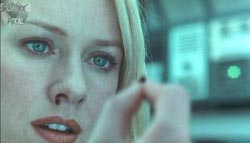
|

|
Unheimlich: The fly from the video and the spit out electrode. The Ring (Dreamworks, 2002). Screenshot courtesy of Snowblood Apple.
How then could the wrong be corrected? What measures could be devised?, every fibre of our symbolic being asks. What can the heroine do? We know what the film says, either version. There is no single measure [sic.]. The diabolical evil can only be pacified, and then only temporarily, by its being sustained or repeated, again and again, ad infinitem. Making a copy of the video is the only thing the heroine did, which her once-partner failed to do. Each person who sees the video has seven days to make a copy of the video, and pass it onto someone else who is bound to do the same.
The Japanese have gamely offered us a sequel. We can only speculate, but the Anglophone version already the uncanny double of the original would indicate that properly there is no point.









